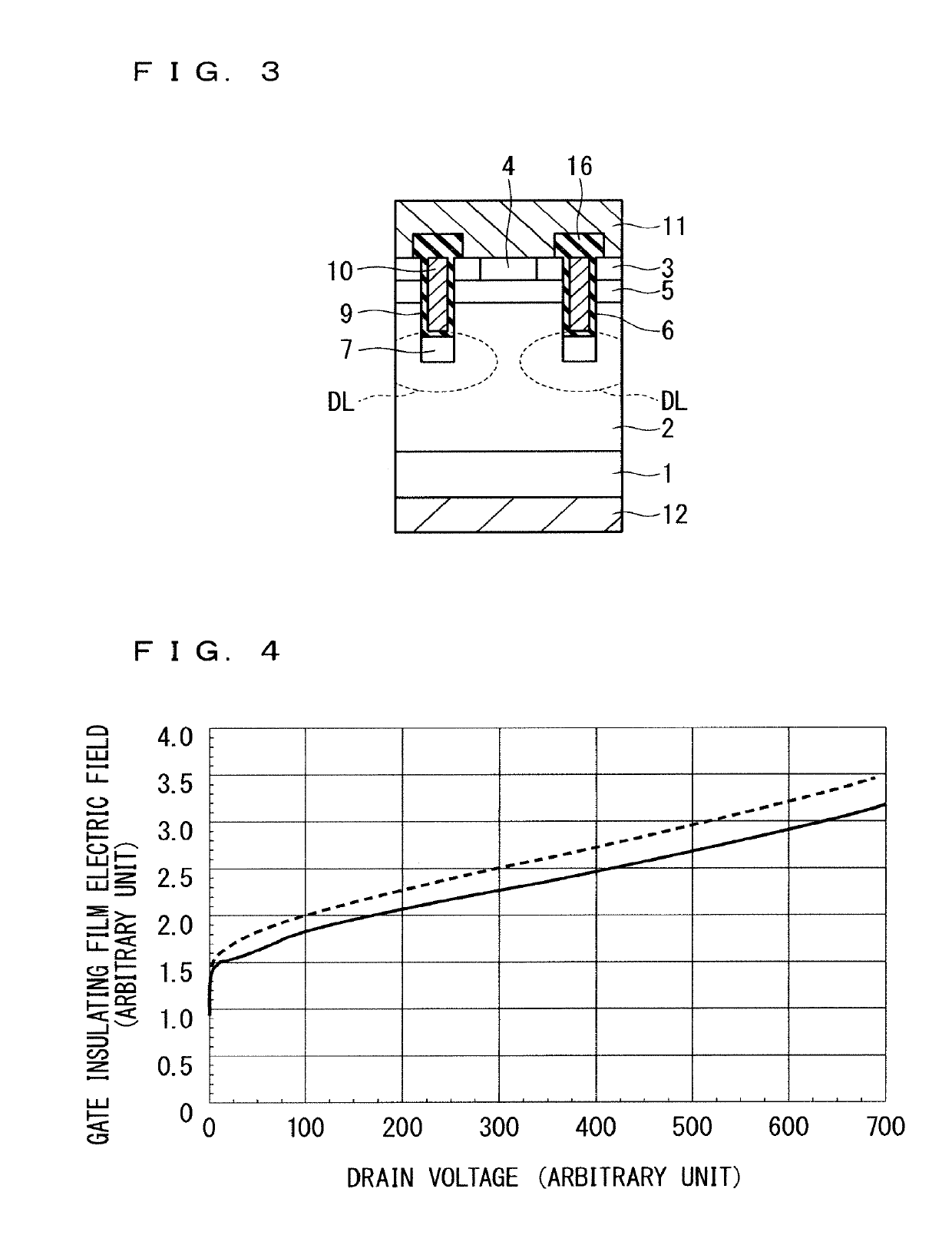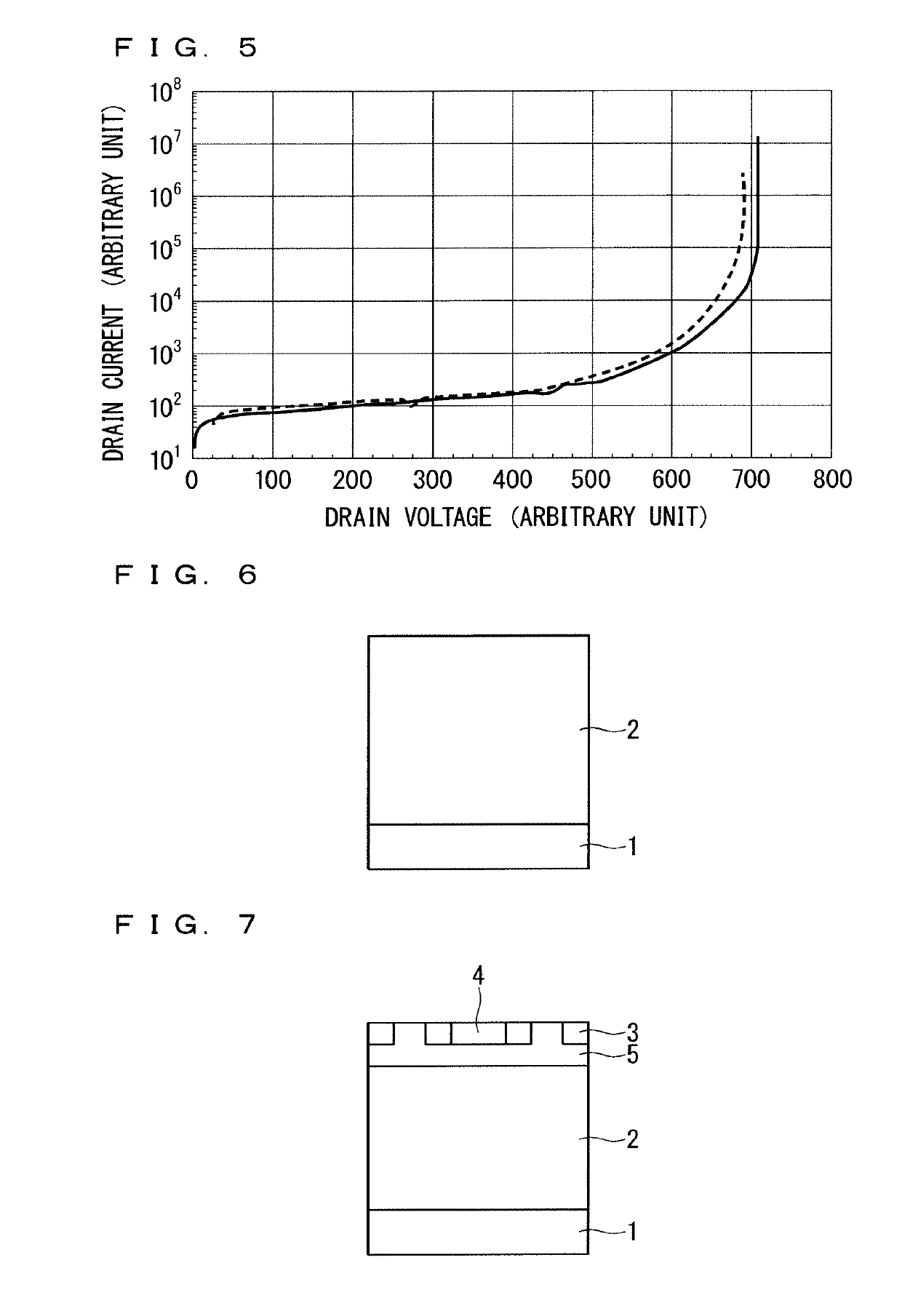Semiconductor device and power conversion device
a technology of semiconductor devices and power conversion devices, which is applied in the direction of power conversion systems, semiconductor devices, control systems, etc., can solve the problems of increasing the possibility of defects, increasing the intensity at the bottom of the trench, and deteriorating the reliability of gate insulating films, so as to improve the trade-off relationship and reduce the effect of on-resistan
- Summary
- Abstract
- Description
- Claims
- Application Information
AI Technical Summary
Benefits of technology
Problems solved by technology
Method used
Image
Examples
first embodiment
[0060]
[0061]FIG. 1 is a sectional view schematically showing a partial configuration of a field effect transistor (SiC-MOSFET) 100 having a MOS structure formed on a SiC substrate. In FIG. 1, the minimum unit structure of the MOS, which is called “cell”, is shown enclosed by broken lines, and the actual SiC-MOSFET 100 includes a plurality of cells.
[0062]As shown in FIG. 1, the SiC-MOSFET 100 is formed on a SiC substrate 1 containing n-type (first conductivity type) impurities at a relatively high concentration in the range of 1×1018 to 1×1021 cm−3.
[0063]On the main surface of the SiC substrate 1, a drift layer 2 (semiconductor layer) containing n-type impurities at a relatively low concentration in the range of 1×1014 to 1×1017 cm−3 is formed. The drift layer 2 is formed by epitaxial growth, for example.
[0064]In an upper layer portion of the drift layer 2, a source region 3 (first semiconductor region) containing n-type impurities (donor impurities) of approximately 1×1019 cm−3 is d...
second embodiment
[0132]FIG. 26 is a sectional view schematically showing a partial configuration of a SiC-MOSFET 200 formed on the SiC substrate. In FIG. 26, the same components as those of the SiC-MOSFET 100 described with reference to FIG. 1 are denoted by the same reference numerals, and repeated descriptions are omitted.
[0133]As shown in FIG. 26, in the SiC-MOSFET 200, the depletion suppressing layer 8 provided in the drift layer 2 between the adjacent trench-bottom protecting layers 7 includes an intermediate point that is horizontally equidistant to the adjacent trench-bottom protecting layer 7, and the depletion suppressing layer 8 is provided at such a position that a distance d1 to a side wall 61 of one of the trenches 6 is different from a distance d2 to a side wall 62 of the other trench 6. That is, the depletion suppressing layer 8 is provided so as to be offset toward one of the trenches 6. Note that the horizontal position of the depletion suppressing layer 8 between the adjacent trenc...
third embodiment
[0142]FIG. 31 is a sectional view schematically showing a partial configuration of a SiC-MOSFET 300 formed on the SiC substrate. In FIG. 30, the same components as those of the SiC-MOSFET 100 described with reference to FIG. 1 are denoted by the same reference numerals, and repeated descriptions are omitted.
[0143]As shown in FIG. 30, in the SiC-MOSFET 300, it is configured such that the depletion suppressing layer 8 provided in the drift layer 2 between the adjacent trench-bottom protecting layers 7 includes a breakdown-voltage sustaining layer 19 containing p-type impurities in the horizontally central part.
[0144]With such a configuration adopted, the breakdown-voltage sustaining layer 19 can be caused to also share the electric field during the off-state applied to the trench-bottom protecting layer 7, and it is possible to reduce the field intensity both at the bottom of the body region 5 and the bottom of the trench 6 and to sustain the breakdown voltage.
[0145]That is, when the ...
PUM
 Login to View More
Login to View More Abstract
Description
Claims
Application Information
 Login to View More
Login to View More - R&D
- Intellectual Property
- Life Sciences
- Materials
- Tech Scout
- Unparalleled Data Quality
- Higher Quality Content
- 60% Fewer Hallucinations
Browse by: Latest US Patents, China's latest patents, Technical Efficacy Thesaurus, Application Domain, Technology Topic, Popular Technical Reports.
© 2025 PatSnap. All rights reserved.Legal|Privacy policy|Modern Slavery Act Transparency Statement|Sitemap|About US| Contact US: help@patsnap.com



